| Site: Big Frog Trail, Polk County, TN Date: 2004-May-08 | Photographer: Gerald C Williamson |
| Cypripedium acaule is an orchid whose showy pink blossom tops a stem that rises from the plant's basal leaves. | |

|
| Site: Big Frog Trail, Polk County, TN Date: 2009-May-09 | Photographer: Gerald C Williamson
Nikon D60
1/40f/11 ISO200
Tamron SP 90MM f/2.8 AF Macro
90mm (135 equiv) Flash: Yes |
| Pink Ladyslipper has a hairy flower stalk topped by the showy blossom. The upper lateral petals are yellow- to purple-brown, and the lower petal forms a pink pocket that gives the ladyslipper its common names. | |
Click on the photo for a larger image
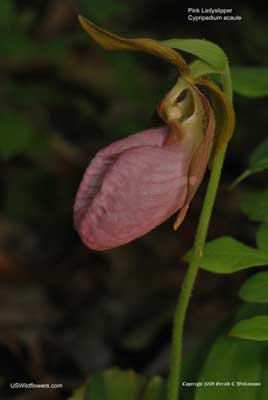
|
| Site: Pigeon Mountain - Rocky Lane, Walker County, Ga Date: 2011-April-17 | Photographer: Gerald C Williamson
Nikon D40 |
| Bees are attracted to the aroma of the ladyslipper, and enter through a slit in the front of the swollen lower petal (the "slipper.") The slit closes behind them and they can't exit back out the way they came, and are forced to climb up past the pollen-laden stamens to exit through the hole at the top. The bee must pass under the stigma on its way out, depositing pollen from another plant if this isn't the first one they've visited. | |
Click on the photo for a larger image
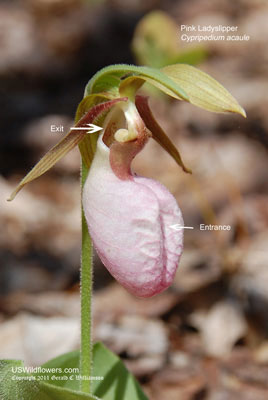
|
| Site: Pigeon Mountain - Rocky Lane, Walker County, Ga Date: 2014-May-02 | Photographer: Gerald C Williamson
Nikon D7000 |
| About 1 in 10 Cypripedium acaule plants in a population will be pollinated successfully and develop seeds. The fruit, shown here as a leftover from last seaon, contains thousands of miniscule seeds, but the seeds do not hold any food reserves. Germination and plant growth requires that they land on soil containing a specific fungus that provides the necessary nutrients. | |
Click on the photo for a larger image
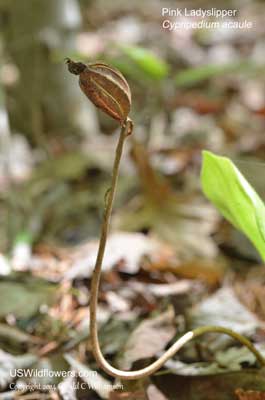
|
| Site: Pigeon Mountain - Rocky Lane, Walker County, Ga Date: 2013-May-02 | Photographer: Gerald C Williamson
Nikon D7000
Tamron SP 90MM f/2.8 AF Macro |
| New Cypripedium acaule blossom along with last years fruit capsule (seed pod.) The seed pod is the culmination of many years of maturing of the plant, which can live for twenty years. Germination of the seeds results from a symbiotic relationship with a Rhizoctonia fungus, which breaks open the seed and provides nutrients to the seed. As the plant matures and producing its own nutrients, the fungus received nutrients from the Cypripedium acaule plant roots. | |
Click on the photo for a larger image
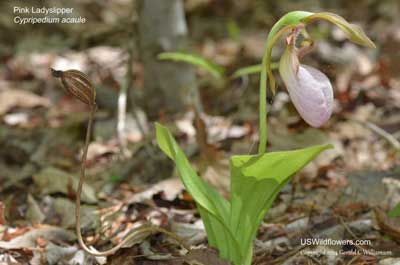
|
| Site: Chattahoochee National Forest, White County, Ga Date: 2011-May-02 | Photographer: Gerald C Williamson
Nikon D7000
Tamron SP 90MM f/2.8 AF Macro |
| White moth (perhaps a Spilosoma species) on a Pink Ladyslipper. | |
Click on the photo for a larger image
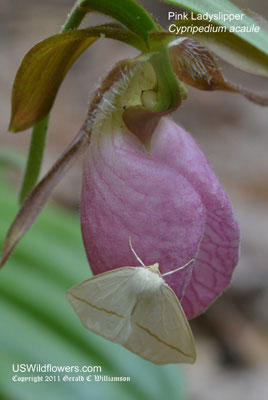
|
| Site: Pigeon Mountain - Rocky Lane, Walker County, Ga Date: 2011-April-19 | Photographer: Gerald C Williamson
Nikon D7000 |
| Cypripedium acaule lip (slipper / pouch) color ranges from magenta to much paler pinks and on relatively rare occasions, to white. | |
Click on the photo for a larger image
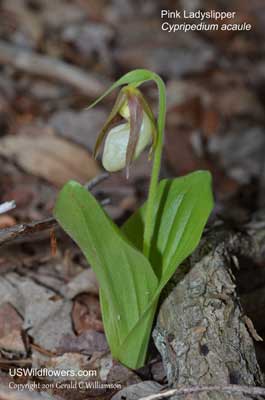
|
References used for identification and information:








